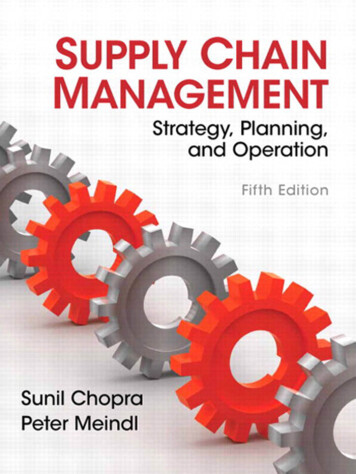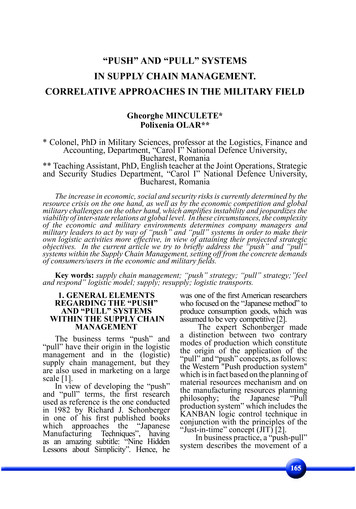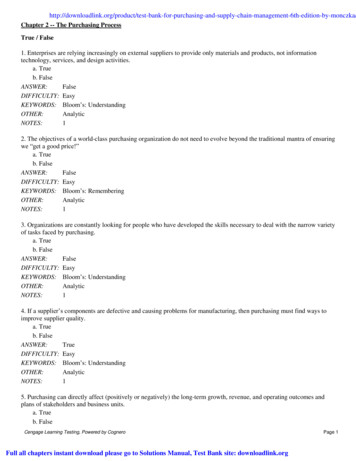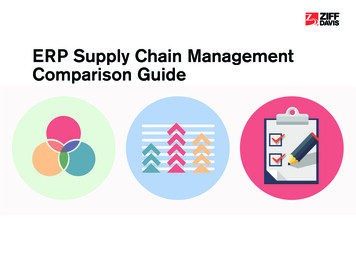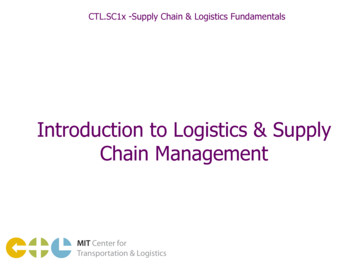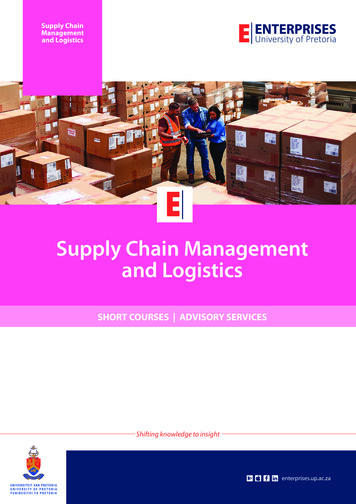
Transcription
COPYRIGHT CROOM, ROMANO & GIANNAKIS. NOT TO BE REPRODUCEDSUPPLY CHAIN MANAGEMENT: AN ANALYTICALFRAMEWORK FOR CRITICAL LITERATURE REVIEWDr. Simon Croom1, Pietro Romano2 and Mihalis Giannakis112Warwick Business School, University of Warwick, Coventry CV4 7AL, UKDepartment of Management and Engineering, University of Padua, Vicenza, ItalyABSTRACTThere can be little dispute that supply chain management is an area ofimportance in the field of management research, yet there have been fewliterature reviews on this topic (Bechtel and Mulumudi, 1996; Harland,1996; Cooper, Lambert & Pagh, 1998). This paper sets out not to review thesupply chain literature per se, but rather to contribute to a critical theorydebate through the presentation and use of a framework for thecategorisation of literature linked to supply chain management. The study isbased on the analysis of a large number of publications on supply chainmanagement (books, journal articles, and conference papers) using aProcite database from which the literature has been classified accordingto two criteria: a content-oriented criterion, and a methodology-orientedcriterion.IntroductionThis paper is a 'thought paper' and arose from our discussions about the nature of theacademic study of supply chain management, a conversation that has indeed been ongoing for a number of years (see Croom & Saunders, 1995). Our concern was withthe nature of research in supply chain management, and more specifically withexactly what would constitute the domain of supply chain management as amanagement discipline. From these discussions this paper developed in order topresent a basis for our debate and development around the field of supply chainmanagement by attempting to consolidate current learning, identify possible gaps,and thereby pose possible future directions for development. Our contention thatsupply chain management should begin to be seen as a discipline in much the sameway as marketing (Malhotra, 1999) has been seen as contentious, not least by earlyreviewers of the paper, yet we stand by this claim, citing Long & Dowells (1989)argument that " disciplines are distinguished by the general (discipline) problemthey address." (Cited in Tranfield and Starkey 1998). What we set out to establish inthis paper is in fact the general problem domain of supply chain management,1
COPYRIGHT CROOM, ROMANO & GIANNAKIS. NOT TO BE REPRODUCEDthereby, we hope, contributing to the development of a discipline in supply chainmanagement. Tranfield and Starkey also note the underlying soft, applied, divergentand 'rural' nature of management research, and further argue that there is a real needin any field of social research to identify the cognitive components of the subject(Tranfield & Starkey, 1998). Their paper has been instrumental in our approach tothe challenge of undertaking a critical literature review of the field of supply chainmanagement, and this paper's focus on mapping and classifying the area has beenmotivated by their claim that " a key question for any applied filed concerns thestrategic approach taken to its mapping" (p. 349).Supply chain management and other similar terms, such as network sourcing, supplypipeline management, value chain management, and value stream management havebecome subjects of increasing interest in recent years, to academics, consultants andbusiness management (Christopher, 1992; Hines, 1994; Lamming, 1996; Saunders,1995, 1998). It is recognised in some parts of the literature that the supply chainshould be seen as the central unit of competitive analysis (Macbeth & Ferguson,1994; Cox, 1997). Companies will not seek to achieve cost reductions or profitimprovement at the expense of their supply chain partners, but rather seek to makethe supply chain as a whole more competitive. In short, the contention in that it issupply chains, and not single firms, that compete is a central tenet in the field ofsupply chain management. (Christopher, 1992; Macbeth & Ferguson, 1994)Supply chain management has received attention since the early 1980s, yetconceptually the management of supply chains is not particularly well-understood,and many authors have highlighted the necessity of clear definitional constructs andconceptual frameworks on supply chain management (Saunders, 1995, 1998; New,1995; Cooper, Lambert & Pagh, 1997; Babbar & Prasad, 1998)2
COPYRIGHT CROOM, ROMANO & GIANNAKIS. NOT TO BE REPRODUCEDSaunders (1995) warns that pursuit of a universal definition may 'lead tounnecessary frustration and conflict', and also highlights the fragmented nature ofthe field of supply chain management, drawing as it does on various antecedentsincluding industrial economics, systems dynamics, marketing, purchasing and interorganisational behaviour. The scientific development of a coherent supply chainmanagement discipline requires that advancements be made in the development oftheoretical models to inform our understanding of supply chain phenomena. As anillustration, the application of Forrester's (1961) industrial dynamics model appliedto supply chains (the 'Forrester Effect') exemplifies such a model. Its value lies inthe ability to aid understanding of the actions of materials flows across a chain, andhas provided a basis for further advancement of understanding supply chaindynamics. (E.g. see Sterman, 1989; Towill, 1992; Van Ackere, Larsen & Morecroft,1993 and Lee, Padmanabhan & Whang, 1997). Cooper et al. (1997) support thisview, pointing to the fact that whilst supply chain management as a concept is arecent development, much of the literature is predicated on the adoption andextension of older, established theoretical concepts.In this paper our concern is not so much with advancing theory per se, but inproviding a taxonomy with which to map and evaluate supply chain research. In theprocess, it is our contention that we also provide a topology of the field of supplychain management, which may provide a fruitful means of delineating or definingthe subject domain. This is not necessarily a novel idea, Lamming (1993), forexample, provides a map of antecedent literature for his development of the LeanSupply Model, which again supports our claim that there is a need for a topologicalapproach to the development of supply chain theory.3
COPYRIGHT CROOM, ROMANO & GIANNAKIS. NOT TO BE REPRODUCEDThis paper presents the results of a literature survey in the field of supply chainmanagement.The main purposes of the survey are: to look at some major issues in supply chain management literature and topresent a framework for classification and analysis to describe and evaluate the methodologies used in supply chain managementliteratureThe paper is organised in five sections. In section one some definitions of supplychain management are examined, underlining differences and common aspects, inorder to better trace the boundaries of the concept the paper is on and to highlightthe difficulties of its definition. One of the reasons for the lack of a universaldefinition of supply chain management is the multidisciplinary origin and evolutionof the concept. Section two considers the bodies of literature associated with supplychain management and discusses the different perspectives adopted by variousauthors. In section three we explain the framework and the methodology used forclassifying the literature analysed and we present the results of literature review.Section four presents a summary and some conclusions we can draw from the workin terms of moving towards a disciplinary approach to supply chain management.Section five contains an extensive reference list.The Supply Chain Management LandscapeIn providing a topology of the supply chain landscape we support New (1995) andSaunders (1995) contention that within the supply chain management literature thereis a confusing profusion of overlapping terminology and meanings. As aconsequence, in the literature many labels can be found referring to supply chainand to practices for supply chain management, including: integrated purchasing4
COPYRIGHT CROOM, ROMANO & GIANNAKIS. NOT TO BE REPRODUCEDstrategy (Burt, 1984), supplier integration (Dyer, Cho & Chu, 1998), buyer-supplierpartnership (Lamming, 1993), supply base management, strategic supplier alliances(Lewis, 1995), supply chain synchronisation (Tan et al., 1998), network supplychain (Nassimbeni, 1998), value added chain (Lee and Billington, 1992), lean chainapproach (New and Ramsay, 1995), supply pipeline management (Farmer & vanAmstel, 1990).), supply network (Nishiguchi, 1994), value stream (Jones, 1995).As a first step, we set out in table 1 to highlight a sample of definitions associatedwith the concept of supply chain management found in the literature analysed. Thistable is not intended to provide a comprehensive review of supply chain definitions(see for example Cooper, Lambert and Pagh 1997), rather the purpose here is tohighlight some of the contrasting approaches to supply chain management existingin the literature.AUTHORS DEFINITIONSupply chain management encompasses materials/supply management from the supply of basic rawTan et al.materials to final product (and possible recycling and re-use). Supply chain management focuses on how(1998)Berry et al.(1994)Jones r(1992)firms utilise their suppliers’ processes, technology and capability to enhance competitive advantage. It is amanagement philosophy that extends traditional intra-enterprise activities by bringing trading partnerstogether with common goal of optimisation and efficiency.Supply chain management aims at building trust, exchanging information on market needs, developing newproducts, and reducing the supplier base to a particular OEM (original equipment manufacturer) so as torelease management resources for developing meaningful, long term relationship.An integrative approach to dealing with the planning and control of the materials flow from suppliers to endusers.External Chain is the total chain of exchange from original source of raw material, through the various firmsinvolved in extracting and processing raw materials, manufacturing, assembling, distributing and retailing toultimate end customers.A network of firms interacting to deliver product or service to the end customer, linking flows from rawmaterial supply to final delivery.Network of organisations that are involved, through upstream and downstream linkages, in the differentprocesses and activities that produce value in the form of products and services in the hands of the ultimateconsumer.Networks of manufacturing and distribution sites that procure raw materials, transform them intointermediate and finished products, and distribute the finished products to customers.Lee andBillington(1992)The set of entities, including suppliers, logistics services providers, manufacturers, distributors and resellers,Kopczakthrough which materials, products and information flow.(1997)Lee and Ng A network of entities that starts with the suppliers’ supplier and end with the customers’ customers for theproduction and delivery of goods and services.(1997)Table 1 – A Sample of Definitions of Supply chain management5
COPYRIGHT CROOM, ROMANO & GIANNAKIS. NOT TO BE REPRODUCEDFrom these selected definitions we are able to partially confirm Saunders (1995)statement that most definitions of supply chain management share at least one thingin common with each other: “.they focus on the external environment of anorganisation, with the boundaries of the latter defined conventionally in terms of anentity identified legally as a company or some other form of business unit.” Assuch definitions are based on metaphors (chains, pipelines, etc.) or “ideal types”rather than “objective entities”, he concludes that “ attempts to pursue universaldefinitions may lead to unnecessary frustration and conflict”. However, in a numberof management fields the study of supply chains concentrates on internal supplychains (Harland, 1996), notably the business re-engineering (Lee & Dale, 1998) andoperations management literature (Slack et al, 1998)The lack of a universal definition of supply chain management is in part due to theway the concept of supply chain has been developed. In fact, as it will be explainedin next section, the concept of supply chain has been considered from differentpoints of view in different bodies of literature. Such a multidisciplinary origin andevolution is reflected in the lack of robust conceptual frameworks for thedevelopment of theory on supply chain management. As a consequence the schemesof interpretation of supply chain management are mostly partial or anecdotal with arelatively poor supply of empirically validated models explaining the scope andform of supply chain management, its costs and its benefits.Bodies of literature associated with supply chain managementThe origins of the concept of supply chain management are unclear, but itsdevelopment was initially along the lines of physical distribution and transport,6
COPYRIGHT CROOM, ROMANO & GIANNAKIS. NOT TO BE REPRODUCEDusing the techniques of industrial dynamics, derived from the work of Forrester(1961). Another antecedent can be found in the Total Cost approach to distributionand logistics (Heckert and Miner, 1940; Lewis, 1956). Both these approaches showthat focusing on a single element in the chain can not assure the effectiveness of thewhole system.The term supply chain management has not been used only with regard to thelogistic activities and the planning and control of materials and information flowsinternally within a company or externally between companies. Some authors haveused it to describe a strategic, inter-organisation issues (Cox, 1997), others todiscuss an alternative organisational form to vertical integration (Thorelli, 1986),others to identify and describe the relationship a company develop with its suppliers(Sako, 1992; Lamming, 1993; Hines, 199
SUPPLY CHAIN MANAGEMENT: AN ANALYTICAL FRAMEWORK FOR CRITICAL LITERATURE REVIEW . strategy (Burt, 1984), supplier integration (Dyer, Cho & Chu, 1998) , buyer-supplier partnership (Lamming, 1993), supply base management, strategic supplier alliances (Lewis, 1995), supply chain synchronisation (Tan et al., 1998), network supply chain (Nassimbeni, 1998), value added chain


